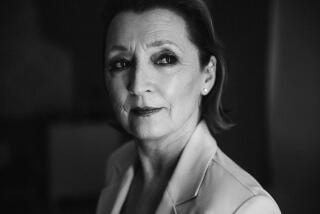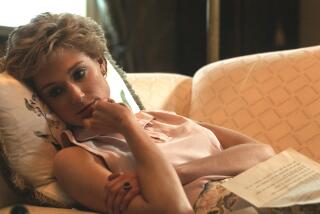You’re not the only one Googling the history behind ‘The Crown’
- Share via
Was Prince Philip related to Nazis?
What caused the Great Smog of London?
Was Princess Margaret’s husband bisexual?
Queen Elizabeth visits Aberfan disaster
If you’ve ever seen an episode of the Netflix series “The Crown,” chances are you’ve Googled one of these phrases or something like it — possibly while watching the show.
Viewer engagement with a TV series is frequently defined by social media chatter, and watching TV is often a chance to shut out the news, but Netflix’s period drama is an outlier, one that prompts a different kind of participation: research. Though its narrative of Queen Elizabeth II and her family already doubles as a lesson on British history, politics and social mores, many viewers partake in extra-credit fact-finding of their own.
Each time a new batch of episodes arrives, as Season 3 did Sunday, viewers turn to the internet to fill in the gaps and figure out where writer and creator Peter Morgan has taken some creative license, leading to dramatic upticks in Wikipedia page views and Google sleuthing.
You’ve heard of binge-watching, but “The Crown” inspires binge-searching.
Consider Peter Townsend, the equerry whose doomed romance with Princess Margaret is depicted in the show’s first season. In the month before “The Crown” debuted in November 2016, Townsend’s Wikipedia page drew an average of 669 visitors a day. In the month following its debut, the number of daily visitors grew exponentially to 45,676, according to page-view statistics available on Wikipedia. Page views for Queen Elizabeth, Prince Philip and other figures in the series peak with each new season.
Worldwide Google searches for the Great Smog of London, a long-forgotten meteorological phenomenon depicted in the first season of “The Crown,” rose sharply in the week following its Netflix release; there was a similarly pronounced surge in Google searches for “Prince Philip Nazis” in the 10 days after the premiere of the second season, which explored the Duke of Edinburgh’s German family connections.
Searches for Anthony Blunt, a Soviet spy who took cover as the queen’s art adviser — an incident dramatized in the first episode of Season 3 — spiked Sunday.
This appetite for more information has led to a cottage industry of search-friendly explainers and fact-checking articles in publications like Vanity Fair, Town & Country and the Washington Post.
Pop culture-fueled curiosity is not a new phenomenon. Films based on historical events have long led moviegoers to pore over and dissect their contents. But unlike a movie theater, where phone usage is still generally frowned upon, there’s more freedom to whip out a phone or a laptop at home — sometimes without even pressing pause — and fall into the Google abyss with TV programs that depict real life. Other recent historical dramas, like “Chernobyl,” “Fosse/Verdon” and “When They See Us” have turned viewers into armchair scholars.
But there’s something particularly irresistible about this process when it comes to “The Crown,” a series that provides a tantalizing glimpse into the private world of the British royal family, often by focusing on lesser-known chapters in their story or approaching the more familiar from an unexpected point of view. There’s also Morgan’s tendency to go easy on the exposition, sometimes skipping ahead by a year or more between episodes, which leaves the audience to play catch-up. Especially for American viewers, to whom the happenings in “The Crown” may be no more than the stuff of textbooks or trivia games, the series can feel like a crash course in 20th century British history.
“Everyone believes they know these people better than they do because they are so public and they’ve been part of our lives and our parents’ lives,” says Annie Sulzberger, head of research on “The Crown.” “So that when something seems unknown or surprising in the show, people simply can’t believe they didn’t know.”
The sweeping drama has delved into a smorgasbord of events, both major and obscure, international and deeply personal — from the 1956 Suez Crisis, which put a strain on Britain’s relationship with the U.S., to Prince Philip’s brutal childhood and rumored infidelities.
Season 3, which spans the years 1964 to 1977, features plots about Labor leader Harold Wilson’s ascent to prime minister, an attempted coup against him, the 1966 Aberfan disaster — in which an avalanche of coal waste barreled through a town in Wales, killing 144 people — and the introduction of a young Camilla Parker Bowles, then known as Camilla Shand.
Research plays a central role in the creative process on “The Crown,” which in lieu of a traditional writers room has a five-person research team. Before Morgan begins writing each season, he informs the team which years he plans to cover, and they create a detailed timeline of significant personal and political events — some well-known, others less so.
“Really, what he’s asking us to do is surprise,” Sulzberger says. “He doesn’t feel he has to cover what everybody expects him to.”
Jeffrey Guhin, an assistant professor of sociology at UCLA, began tumbling down the rabbit hole in August after the birth of his daughter. In the morning, while his wife, Mary Katherine Scheena, was nursing, the couple made their way through the first two seasons of the Netflix drama. And, inevitably, attention would turn from the TV screen to the phone screen.
“My wife would look over at me and say, ‘You’re not watching the show,’” Guhin says of his search habits, noting that his sources of choice include Wikipedia, Vanity Fair and whatever link grabs his attention. “And I would say, ‘No, but I need to find out about this thing.’ And, of course, I didn’t actually need to find out about this thing, but the show totally pulls me in.”
Among his deep dives, Guhin has brushed up on English prime ministers: “I didn’t know much about the prime ministers that came before Margaret Thatcher aside from, obviously, [Winston] Churchill.” A Season 2 episode that depicts the queen’s budding relationship with famous American evangelist Billy Graham also led to a prolonged research binge. Sometimes, Guhin and Scheena’s curiosities would be in sync, like the time they both wanted to figure out if King George VI’s brother Edward VIII — known after his abdication as the Duke of Windsor — was “really that big a jerk.”
It becomes, Guhin says, “kind of like a more intellectual version of ‘Pop-Up Video,’” VH1’s famed series of annotated music videos.
U.K.-based Steven Birney, 45, has never been all that interested in the royal family. But after recommendations from friends, he and his wife, Sarah, started watching “The Crown.” And he now knows a lot more about the controversial portrait of Churchill rendered by artist Graham Sutherland and young Prince Charles’ rough time in boarding school at Gordonstoun.
“It’s fun, the way it engages you and almost prompts you to learn more,” Birney says. “It brings an extra dimension to the TV viewing experience. And it can lead to interesting conversations. When [my wife and I] visited my parents, who lived through a lot of it and remember the actual events, it [led] to all these interesting discussions.”
But even the most curious can get overwhelmed by it all.
Ilse Gaona, 27, of Sonoma County, isn’t typically drawn to historical films or TV shows. But she decided to give “The Crown” a try this year since she likes the royal family — Meghan Markle and Prince Harry, in particular — and because a person she follows on Twitter kept praising it.
She got to watching on her laptop from the comfort of her bed this summer. And the extracurricular browsing began almost immediately by way of the Wikipedia app on her phone. Gaona says it helps contextualize the motives of the characters. But it has also made watching the series a bit of a slog, she says.
“It interrupts the viewing experience,” she says. “I pause a lot. So it takes me maybe twice the amount of time to watch an episode than the actual run time because I am pausing it so much. I think that’s why I still haven’t even finished Season 1. I’m five episodes in or something.”
She hoped to finish the first season before the new season premiered, but she was quick to note the impulse to research meant it’s unlikely she’ll finish in time.
“I can’t help but look up stuff,” she says.
Even those who grew up in close proximity to the royals have been surprised by “The Crown”
Victoria Arbiter, who appears frequently on television as a royal commentator, lived at Kensington Palace as a teenager when her father, Dickie Arbiter, was press secretary for Prince Charles and Princess Diana. A fan of the series — “I have Netflix until I binge ‘The Crown’ and then I delete it” — she says she’s been surprised to learn so much from the show despite her personal familiarity with its subjects.
Arbiter was “embarrassed” to have known nothing about the Great Smog of London before “The Crown” came along. “That’s where I hit pause and went, ‘What’s that about?’” Like many viewers, she was also fascinated by the portrayal of the queen’s lovelorn sister, Princess Margaret — despite having met her.
“She was always an intriguing figure, but [actress] Vanessa Kirby was so sensational. I did go and Google a lot about Princess Margaret and her husband, Antony Armstong-Jones. I didn’t know much about his photography.”
The series’ research team draws from an array of sources not readily accessible to the average amateur smartphone researcher — newspaper databases, archival footage, cabinet minutes, interviews with former press secretaries and royal biographers.
“I completely understand why people turn to Google for this. They go down the rabbit hole wanting to learn more. But it can sometimes be a shame, because most of what we find is not readily available like that,” says Sulzberger, who admits she’s not immune to the feeling of I-can’t-believe-I-didn’t-know-this provoked by historical drama. (She says she was incredulous after watching “Chernobyl,” even though “this is my job and I should know better.”)
Getting seduced by the research is an on the-job-hazard for Sulzberger, who learned as much as she could about Graham’s 1958 visit to the U.K., the political evolution of royal critic Lord Altrincham and the Duke of Windsor’s connection to the Nazi regime for Season 2.
The team also became fascinated with their research for the Season 3 episode “Moondust,” set during the Apollo 11 moon landing in 1969, poring over the transcripts of the mission minute-by-minute and having “beautiful existential conversations” about its spiritual significance.
Yet even for a professional, getting sucked into the minutiae is not always productive. “You realize it’s not in any way helpful to the story, because it involves so many details you could never get across in a simple bit of dialogue. It really overcomplicates things,” Sulzberger says.
The balancing act between the intimate and the historic makes “The Crown” compelling, said Arianne J. Chernock, an assistant professor of modern British history at Boston University, who describes the prestige drama as the “ultimate reality TV show,” one in which the main characters were “cast before birth.”
“But what makes it different from reality TV,” she adds, “is that the family drama is actually consequential, so their choices have national and international implications.” That — and all the research it inspires.
More to Read
The complete guide to home viewing
Get Screen Gab for everything about the TV shows and streaming movies everyone’s talking about.
You may occasionally receive promotional content from the Los Angeles Times.







